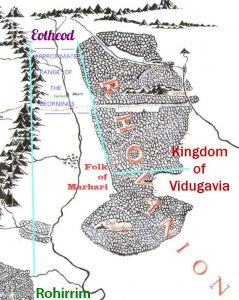Q: How did the Éothéod differ from the Rohirrim?
ANSWER: The full question a reader asked was: “Who where the Éothéods and how different they were from the Rohirrim?”
 The short, technical, boring form of the answer is that they were the exact same people (tribe) but living in different periods of time. The Éothéod were descendants of the Northmen of Rhovanion who survived the destruction of their ancient kingdom and settled in the Vales of Anduin near the Gladden Fields. They fled there in the Third Age year 1856. There they lived and intermarried with other Northmen from Mirkwood and the Vales of Anduin for about 120 years.
The short, technical, boring form of the answer is that they were the exact same people (tribe) but living in different periods of time. The Éothéod were descendants of the Northmen of Rhovanion who survived the destruction of their ancient kingdom and settled in the Vales of Anduin near the Gladden Fields. They fled there in the Third Age year 1856. There they lived and intermarried with other Northmen from Mirkwood and the Vales of Anduin for about 120 years.
After the fall of Angmar Frumgar led his people north to the sources of the Anduin (T.A. 1977), where two rivers called Greylin and Langwell met. This had been the eastern march of Angmar and Frumgar’s people took it for themselves. They slew or drove off the last of Angmar’s people living in the region.
The Éothéod remained there until the year 2510, when Frumgar’s distant descendant Eorl led 7,000 Riders south to Gondor’s aid.
Although Tolkien does not say so, he seems to imply that a few Northmen remained behind each time the main group migrated, usually by writing phrases like “there were now few men” or “few folk lived in those regions” when describing the Vales of Anduin at various times. But he does not explicitly state that all the Men living in the upper Vales of Anduin (the Beornings and the Woodmen) at the time of the War of the Ring were descendants of either the original group of refugees or remnants of the Éothéod.
In Unfinished Tales we learned that all the Northmen of Rhovanion and Eriador were descended from the ancestors of the Beorians and Marachians of Beleriand in the First Age. As such they were the closest relatives of the Dúnedain (or Númenóreans) in Middle-earth. The Men of Dale, the Long Lake, and Mirkwood and the Beornings could simply have been different tribes not descended from the Éothéod. We can never know this.
Culturally there would not have been much difference between the Éothéod and the Rohirrim, except that Tolkien describes some changes in Rohirric society which came about as a result of their settling in Calenardhon, the former northern fief of Gondor.
First, the Rohirrim who settled in the west intermarried with Dunlending families. Freca, Helm Hammerhand’s rival, was the most notable of these mixed-blood Rohirrim. But it’s obvious from Gamling the Old’s knowledge of the Dunlending’s language that there were still connections between the Folk of Westfold and Dunland at the time of the War of the Ring.
Second, the Rohirrim eventually established a formal Muster with three chief Marshals who had specific responsibilities. Tolkien described the Muster of Rohan and how it grew and was reorganized as the years passed in an essay published in Unfinished Tales.
We can also infer some intermarriage with Gondorians (as Thengel married Morwen of Lossarnach). Also, Faramir told Frodo and Sam that the Northmen were becoming more like the Men of Gondor even as they, the Men of Gondor, were becoming more like the Rohirrim. Whereas the Éothéod lived in isolation from Gondor for centuries, the Rohirrim shared certain duties and customs with the folk of Gondor, including the care of Elendil’s original tomb and the defense of the Anduin.
Through subtle hints J.R.R. Tolkien also suggests that the language of Éothéod was different from the language of Rohan. Frumgar and his son Fram were the last of the Gothic-named chieftains descended from Vidugavia. But their names are found in both Gothic (the language Tolkien used to represent the most ancient form of the Northmen’s language in the Third Age) and Old English (the language he used to represent the Rohirric language at the time of the War of the Ring). Hence, we probably should infer that the language of Éothéod was in a transitional stage that was neither exactly like the language of their ancestors nor the language of their descendants.
Beyond those distinctions, though, there isn’t any evidence of significant differences between the Éothéod and the Rohirrim.
# # #
See also:
- How Many Lords of Éothéod were There?
- Why Did the Rohirrim Move South to Gondor?
- What Were the Beornings Like?
- Where Did the Rohirrim Come From?
- Who Were the Men of Mirkwood?
- How Many Tribes of Northmen are There?
- What was Éothéod Like?
Have you read our other Tolkien and Middle-earth Questions and Answers articles?

Good analysis! Some small cultural differences but in the end Rohirrim actually saved much of the heritage of their ancestors. Aragorn thinks that indeed Rohirrim had some ties with people of Vale of Anduin:
“…It was in forgotten years long ago the Eorl the Young brought them out of the North, and their kinship is rather with the Bardings of Dale, and with the Beornings of the Wood, among whom many still be seen many men tall and fair, as are the Riders of Rohan. At least they will not love the Orcs.” The Two Towers: The Riders of Rohan
But in general it’s easier to assume that Lake-men of Esgaroth, Woodmen of Mirkwood, Beornings (among whom there may be many fascinating skin-changers shapeshifting into bears :)) and Men of Dale/Bardings are cultures of their own, they share similar ethnicity but developped into specific peoples.